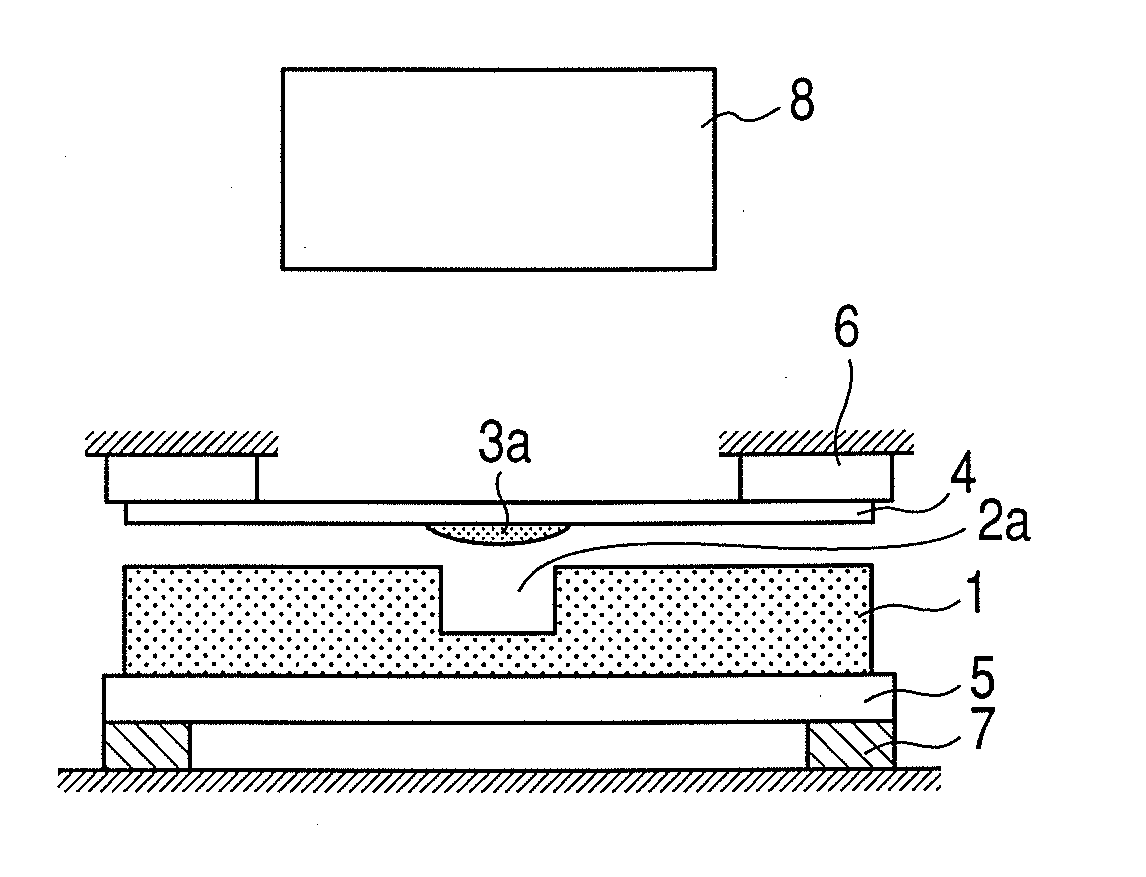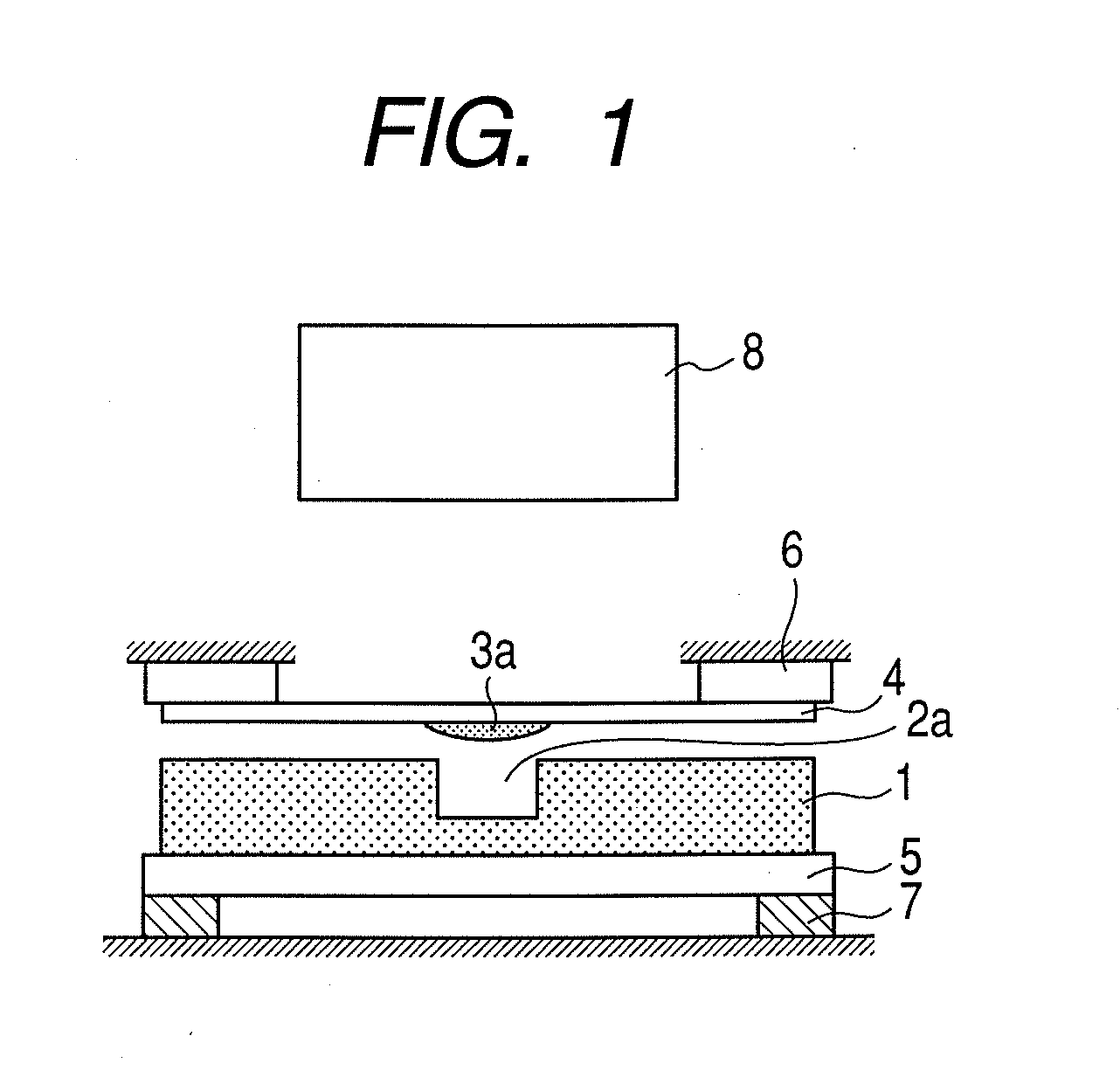Method of producing microfluidic device
a microfluidic device and microfluidic technology, applied in the direction of laboratory glassware, instruments, suspensions, etc., can solve the problems of reducing the productivity (yield) prone to deformation retaining strength, and reducing the efficiency of the microfluidic device, so as to suppress the occurrence of non-joint parts, improve the adhesion thereof, and reduce the yield
- Summary
- Abstract
- Description
- Claims
- Application Information
AI Technical Summary
Benefits of technology
Problems solved by technology
Method used
Image
Examples
embodiments
First Embodiment
[0035]A first embodiment of the present invention is described with reference to FIG. 1 to FIGS. 4A and 4B.
[0036]FIG. 1 is a schematic diagram of the configuration of an apparatus describing the first embodiment of the present invention. In FIG. 1, a substrate 1 is formed of plastic or glass and provided with a fine depressed portion 2a such as a groove being a channel and a hole being a chamber. The apparatus also includes an ultraviolet (UV) curable resin 3 (the ultraviolet curable resin still to be cured is represented by 3a, and hereinafter the cured UV curable resin is represented by 3b).
[0037]The UV curable resin 3a is adhered on the face of the quartz substrate 4 opposing the substrate 1. The face of the quartz substrate 4 opposing the substrate 1 is preferably subjected in advance to a surface treatment. More specifically, a release agent such as a silane coupling agent is preferably applied thereto. Since quartz is high in transmittance of ultraviolet rays, ...
second embodiment
[0046]In the first embodiment, a method is described in which the UV curable resin 3a is adhered only to a portion of the quartz substrate 4 opposing the fine depressed portion 2a of the substrate 1, thereby to cause the UV curable resin 3b cured by UV rays to serve as the cover for the fine depressed portion 2a on the substrate 1. In the second embodiment, a method is described in which the UV curable resin 3a is adhered to substantially the entire face of the quartz substrate 4 opposing the substrate 1 and the UV curable resin is caused to serve as the cover for the fine depressed portion 2a on the substrate 1.
[0047]FIGS. 5A and 5B are schematic diagrams describing the second embodiment of the present invention. A shielding film 41 shields ultraviolet rays in FIG. 5A. The film is formed by evaporating metal such as chromium with the portion of the fine depressed portion 2a masked so that the portion can be irradiated with UV rays in view from the UV irradiation unit 8 when the fin...
third embodiment
[0051]In the first and the second embodiment, a method is described in which the UV curable resin 3a is adhered to the quartz substrate 4 in advance and oppose the substrate 1 and then cured by UV rays, thereby to cause the UV curable resin 3b to serve as the cover for the fine depressed portion 2a on the substrate 1. In the third embodiment, a method is described in which the quartz substrate 4 is caused to oppose the substrate 1 and the UV curable resin 3a is sent and cured by UV rays, thereby to cause the UV curable resin 3b to serve as the cover for the fine depressed portion 2a on the substrate 1.
[0052]FIG. 6 is a schematic cross section describing the third embodiment of the present invention. In FIG. 6, water 10 is caused to flow to the fine depressed portion 2a on the substrate 1 while forming a layer and an interface between the water 10 and the UV curable resin 3a. For this reason, there are provided a pipe 11 for sending the UV curable resin 3a and the water 10 and connec...
PUM
| Property | Measurement | Unit |
|---|---|---|
| Adhesion strength | aaaaa | aaaaa |
Abstract
Description
Claims
Application Information
 Login to View More
Login to View More - R&D
- Intellectual Property
- Life Sciences
- Materials
- Tech Scout
- Unparalleled Data Quality
- Higher Quality Content
- 60% Fewer Hallucinations
Browse by: Latest US Patents, China's latest patents, Technical Efficacy Thesaurus, Application Domain, Technology Topic, Popular Technical Reports.
© 2025 PatSnap. All rights reserved.Legal|Privacy policy|Modern Slavery Act Transparency Statement|Sitemap|About US| Contact US: help@patsnap.com



